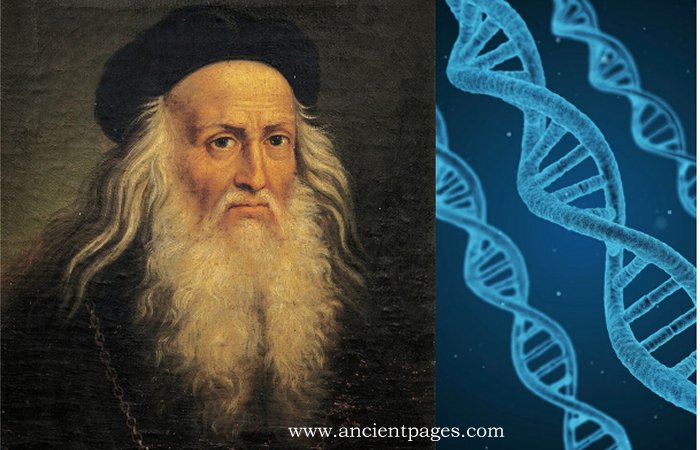Conny Waters – AncientPages.com – Leonardo Da Vinci has been celebrated as a visionary artist, scientist, and inventor for over five centuries, known for his extraordinary talent and groundbreaking experiments. Today, an international team of researchers uncover the biological secrets of the greatest genius of the Renaissance.
In their newly published book, “Genìa Da Vinci. Genealogy and Genetics for Leonardo’s DNA,” released by Angelo Pontecorboli Editore, esteemed scholars Alessandro Vezzosi and Agnese Sabato of the Leonardo Da Vinci Heritage Association in Vinci present the results of three decades of meticulous genealogical research. Supported by the Municipality of Vinci, this publication meticulously documents an extensive family tree dating back to 1331, encompassing 21 generations and over 400 individuals. This scholarly work establishes a foundation for one of the most sophisticated historical-genetic studies ever conducted: the reconstruction of Leonardo da Vinci’s genetic profile.
Through detailed examination of sources and archival documents, now compiled in their book, Vezzosi and Sabato have successfully traced the family branches to which Leonardo da Vinci belonged.
They identified 15 direct male-line descendants genealogically linked to both Leonardo’s father and his half-brother, Domenico Benedetto. This discovery enabled David Caramelli, coordinator of the Leonardo DNA Project for anthropological and molecular studies and Director of the Department of Biology at the University of Florence, along with forensic anthropologist Elena Pilli, to conduct DNA testing on six of these descendants. Their analysis showed that segments of the Y chromosome—used for individual identification—matched among these men, confirming genetic continuity in the Da Vinci male line since at least the 15th generation.
The authors have verified the presence of a Da Vinci family tomb within the Church of Santa Croce in Vinci, which is presently undergoing archaeological excavation in partnership with the University of Florence.
This site may serve as the final resting place for Leonardo’s grandfather Antonio, his uncle Francesco, and several half-brothers—Antonio, Pandolfo, and Giovanni.
The leaders of this excavation effort, anthropologists Alessandro Riga and Luca Bachechi from the University of Florence, have retrieved bone fragments that have been subjected to radiocarbon dating. One specimen aligns chronologically with Leonardo’s presumed relatives and has been analyzed through paleogenomic methods. Preliminary findings by Caramelli and molecular anthropologist Martina Lari suggest that this individual was male.
“Further detailed analyses are necessary to determine whether the DNA extracted is sufficiently preserved,” says Caramelli, who is also President of the University Museum System. “Based on the results, we can proceed with analysis of Y chromosome fragments for comparison with current descendants.”
If the Y chromosome of living descendants matches that found in older remains within the Vinci church tombs, it would validate the accuracy of paternity records and support historical lineage reconstructions established through death registers. This discovery would also enable a more detailed analysis of biological material linked to Leonardo, as well as any traces on his original manuscripts or other works, potentially facilitating the reconstruction of his DNA.
Launched in 2016 at The Rockefeller University, New York, the Leonardo da Vinci DNA Project includes the J. Craig Venter Institute, the University of Florence, and others, supported by various foundations. The project aims to trace the Y chromosome passed from father to son.
Researchers confirmed Leonardo da Vinci’s direct male lineage through DNA analysis of living descendants. This finding enhances our understanding of his genealogy after three decades of research combining historical documentation and genetic testing. Detailed in Genìa Da Vinci: Genealogy and Genetics for Leonardo’s DNA by Alessandro Vezzosi and Agnese Sabato, this discovery is a key achievement for the international initiative exploring da Vinci’s scientific contributions. it is also an essential historical contribution to our knowledge about this great scientist.
“Our goal in reconstructing the Da Vinci family’s lineage up to the present day, while also preserving and valuing the places connected to Leonardo, is to enable scientific research on his DNA,” says Vezzosi.
“Through the recovery of Leonardo’s DNA, we hope to understand the biological roots of his extraordinary visual acuity, creativity, and possibly even aspects of his health and causes of death.”
”Even a tiny fingerprint on a page could contain cells to sequence,” says Jesse H. Ausubel of The Rockefeller University and director of the project. “21st-century biology is moving the boundary between the unknowable and the unknown. Soon we may gain information about Leonardo and other historical figures once believed lost forever.”
The book’s insights go beyond genetics, exploring genealogy, history, and geography over 21 chapters to reveal Leonardo’s environment. By analyzing ancient registries, seven Da Vinci family homes and two properties owned by Leonardo were identified. The authors highlight two figures: Leonardo’s grandfather Antonio, a merchant traveling between Spain and Morocco, and his mother Caterina.
Research suggests Caterina may have been a slave for banker Vanni di Niccolò di ser Vanni. Wills and records from 1449 detail the relationship between Vanni and ser Piero, Leonardo’s father.
The authors reveal a study suggesting a mysterious charcoal drawing, found in Vinci (formerly Bracci hous. It may be attributed to Leonardo. This drawing features distinct elements: a spiral horn, elongated snout, curved beak, hooked teeth, flaming tongue, clawed limbs, pointed ears, pronounced scales, fan-like wings with finger
extensions—hinting at Leonardo’s later flight studies—and a serpentine tail.
Vezzosi and Sabato named it “Unicorn Dragon,” noting its resemblance to Windsor sheet RL 12370 from the 1470s. The Municipality plans to scientifically analyze and restore the large drawing (about 80×70 cm) under the supervision of the Superintendency of Archaeology, Fine Arts, and Landscape for Florence and nearby provinces.
The book suggests Leonardo anticipated concepts now called “epigenetic.” He wrote about heredity, considering diet, blood, and parental behavior’s impact on offspring—still relevant today. Agnese Sabato explains that Leonardo explored human life’s origins beyond biology, noting how conception intertwines nature, emotion, and fate—foreshadowing current genetics-epigenetics themes.
The final chapter explores evocative similarities between some current descendants and Leonardo’s famed self-portrait, offered as a reflection.
Written by Conny Waters – AncientPages.com Staff Writer


